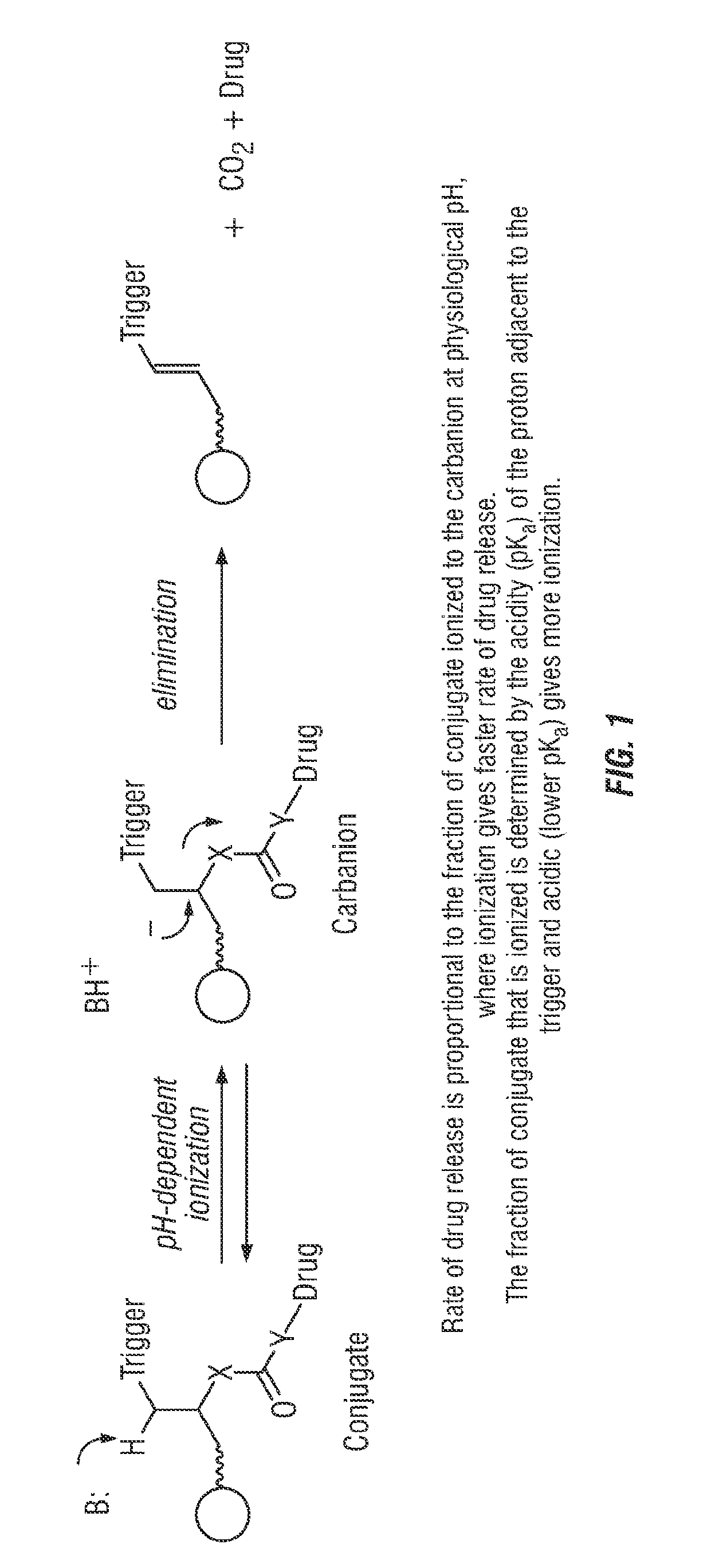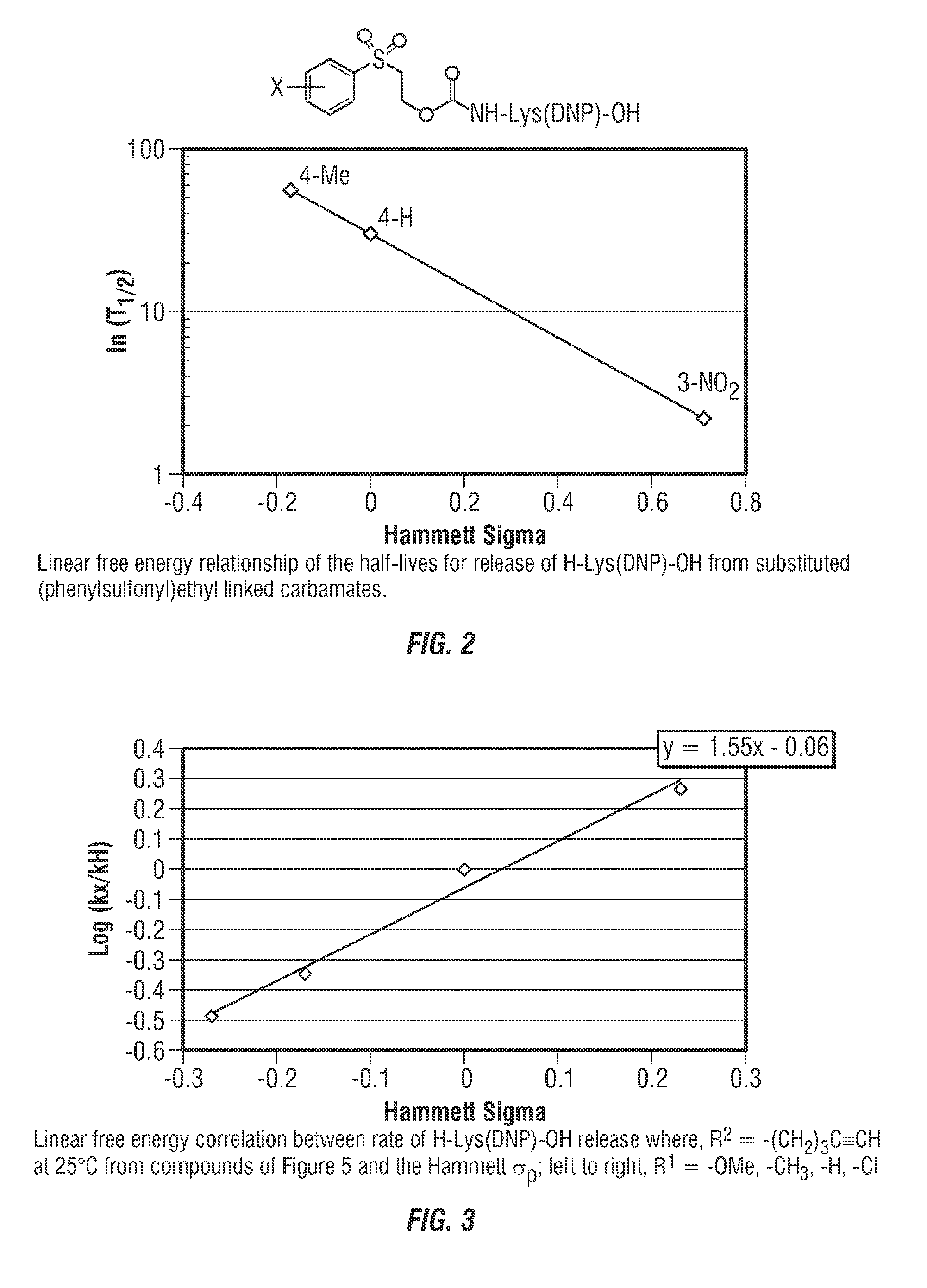Controlled release from solid supports
a technology of solid supports and controlled release, which is applied in the field of medical devices, can solve the problems of unpredictable and difficult to adjust the release rate of drugs in these cases, and the noncovalent content of drugs or growth factors used in these approaches, and achieves the effects of reducing the risk of drug side effects, and reducing the safety of patients
- Summary
- Abstract
- Description
- Claims
- Application Information
AI Technical Summary
Benefits of technology
Problems solved by technology
Method used
Image
Examples
example 1
Release Rate Determination—Phenyl Sulfones
[0228]A series of linker scaffolds having a range of functional groups as potential pKa modulators (substituted aromatics, ketones, nitriles, sulfones) were designed, prepared and linked via carbamate bonds to Ne-2,4-dinitrophenyl-L-lysine (Ne-DNP-Lys) for evaluation of release rates. DNP-Lys was chosen as the released moiety as is water soluble and is a strong chromophore to permit HPLC-UV analysis. This experiment demonstrates that the rate of carbamate cleavage is controllable through the choice of particular substituents on the trigger group.
[0229]
[0230]Starting alcohols, obtained commercially or prepared by standard methods, were converted into N-hydroxysuccinimide (HS) carbonates either using a one-step procedure with disuccinimidyl carbonate (Manoharan, J. Org. Chem. (1999) 64:6468-6472) or by a two-step procedure wherein the alcohol is first converted into the chloroformate using triphosgene / pyridine and then to the carbonate by trea...
example 2
Release Rate Determination—Effect of R5
[0237]From the studies in Example 1, the phenyl sulfone moieties at R1 appeared to provide rates (t1 / 2˜2 to 72 hr) spanning a range suitable for use in drug conjugates. These were converted into bifunctional linkers containing a N-hydroxysuccinimide (NHS) carbonate for attachment to amine-containing molecules and an acylated 3-aminophenyl moiety at R5 for attachment to solid supports directly or via PEG or dendrimers. In particular, conjugates having the general structure shown below were prepared.
[0238]
[0239]Rx=4-chloro, H, 4-methyl, 4-methoxy, 2,4-dimethyl, and 2,4,6-trimethyl;
[0240]Ry=—(CH2)3C≡CH, —(CH2)5N3, —(CH2)2-maleimide
[0241]The NHS carbonate linkers with Ry=—(CH2)3C≡CH were attached to Ne-DNP-Lys, and the rates of Lys(DNP) release were measured in 0.1 M HEPES, pH 7.40 at 25° C. or 37° C. using HPLC. All compounds gave good first-order kinetics, with t1 / 2 ranging from 16 to 120 hours (Table 3) and a temperature coefficient Q12 of 5.7±...
example 3
Effect of Coupling to a Macromolecule
[0244]The linker with Rx=4-methoxy, Ry=—(CH2)3C≡CH coupled to Ne-DNP-Lys was conjugated with 40 kDa PEG-azide using copper-catalyzed Huisgen cycloaddition. Examination of the release of H-Lys(DNP)-OH indicated that the rate of release from the macromolecular conjugate (k=0.0059 h−1, t1 / 2=118 hrs) was similar to that of the unconjugated linker (t1 / 2=94 hr).
[0245]Preliminary results of determination of effects of human sera on the rate of release from PEG-conjugates suggest there may be a uniform 3-fold rate enhancement of cleavage. The conjugate of 40 kDa PEG with this compound was administered to rats to determine pharmacokinetics; stably conjugated Lys(DNP) was also prepared by click chemistry between Nα-hexynoyl-Lys(DNP)-OH and 40 kDa-PEG-azide and administered to rats as a control. Competitive ELISA for DNP-Lys using DNP-BSA and an anti-DNP antibody conjugated to alkaline phosphatase is employed.
PUM
| Property | Measurement | Unit |
|---|---|---|
| temperature | aaaaa | aaaaa |
| temperature | aaaaa | aaaaa |
| molecular weight | aaaaa | aaaaa |
Abstract
Description
Claims
Application Information
 Login to View More
Login to View More - R&D
- Intellectual Property
- Life Sciences
- Materials
- Tech Scout
- Unparalleled Data Quality
- Higher Quality Content
- 60% Fewer Hallucinations
Browse by: Latest US Patents, China's latest patents, Technical Efficacy Thesaurus, Application Domain, Technology Topic, Popular Technical Reports.
© 2025 PatSnap. All rights reserved.Legal|Privacy policy|Modern Slavery Act Transparency Statement|Sitemap|About US| Contact US: help@patsnap.com



